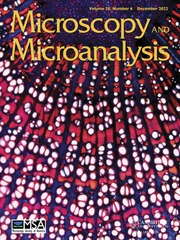No CrossRef data available.
Article contents
Modifying an FESEM for Low-Vacuum Work
Published online by Cambridge University Press: 02 July 2020
Abstract
Environmental SEM has greatly extended the utility of SEM as a result of an ESEM's ability to image volatile and insulating samples. However, many institutions have older high-vacuum SEMs that they cannot afford to replace with an ESEM. For this reason, a simple and inexpensive pressure cell has been developed for performing low-vacuum SEM in a standard microscope. Rather than backfilling the entire analysis chamber with gas, a small volume of higher pressure is confined at the sample surface with the use of a pressure cell that has a small aperture for admitting the primary beam and a gas inlet. Figure 1 is a photograph of such a simple pressure cell.
The aperture for admitting the primary beam needs to be small enough to limit the escaping gas to an amount below what the standard SEM can pump and still maintain high vacuum. On the other hand, the aperture should be as large as possible to provide a useful field of view.
- Type
- Technologists’ Forum: ESEM/Lv/Vp: Imaging at Low Vacuum (Organized by J. Killius)
- Information
- Copyright
- Copyright © Microscopy Society of America 2001
References
1. Mancuso, et al, United States patent #4,785,182 (1988).Google Scholar
2. Meredith, et al., Scanning 18 (1996) 467–473.CrossRefGoogle Scholar
3. Pletnev, and Zukotynski, , J. Vac. Sci. Tech. A 17 (1999) 3521–3524.CrossRefGoogle Scholar




